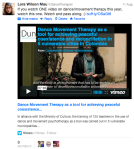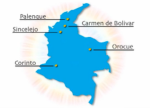This week (July 23-28) DanceAdvantage.net invites the world to participate in a social media based campaign united on the importance of dance: “Why Dance Matters.”
My dance/movement therapy colleague, Donna Newman Bluestein, has done this exquisitely well in her blog, Musings of a Dance/Movement Therapist. I encourage you to take a few minutes to read her post. You can bet I will be quoting her words for a long time.
I, however, am finding it harder to describe the power of dance as she has, so summarily and eloquently. My response seems to be emerging in vivid memories – moments that have stood the test of time over the decades and remain in my consciousness, reminding me of the power of dance to enliven, to connect, to pierce isolation. To express – joy, grief and everything in between. To not only encode memory but also evoke it.
If only I could provide a YouTube link to these unforgettable moments etched in my bodymind. Alas, I will attempt to rely on clumsy and inefficient words to describe what dance does so effortlessly. (Ah yes, how could I forget that one: dance communicates. Dance communicates what even the most skilled wordsmiths can only silhouette.)
And so, I offer these mere silhouettes and hope they do some justice in verbally conveying what was first experienced, so perfectly, nonverbally.
~~ Why Dance Matters ~~
As I reflect on these words, one of the first images that floods my mind is that of me dancing the Two Step with my grandfather and the Schottische with my grandmother at rural community dances when I was a young child. My grandfather passed decades ago and my grandmother is now an amazing and vibrant 90. Those moments of physical touch, of loving gazes from twinkling eyes, of our laughing and moving together will always remain in my heart and bring joy and comfort to me all my life. To have danced with my grandparents…
~~ Why Dance Matters ~~
Every week I enter a room at some psychiatric hospital, prepared to lead a dance/movement therapy group with inpatients who are in crisis. As I enter, I witness withdrawal, disconnection, paralytic depression, isolative preoccupation. Often those with thought disorders are talking to themselves or imagining some delusional yet terrifyingly real threat to their personhood. Attempts at facilitating a group discussion are. . . well, mere attempts. Focus, interaction, listening, organized verbal expression: all these things are nearly impossible to facilitate amongst such a diverse group of individuals challenged with such severe psychiatric symptoms.
But the dance…
The music plays and an ever-surprising, inspiring and magical dance emerges that I feel blessed to witness and partake in every time. I never know how one patient will respond or who will be inspired by whose movement to express themselves in what way. But they do: Respond. Interact. Dance. Sometimes alone, almost always, eventually, with each other as one group. Maybe the group cohesion is only for a few moments but those moments are gold. The voices quiet (or at least are ignored for a bit), the isolation melts, joy – that ever elusive joy – is felt, embodied and expressed. Or perhaps there is sadness and despair or anger – but these feelings are permitted, embodied, symbolized, expressed. People are accepted for who they are and embraced. Nonverbally the dance says We are all welcome here and we have something to say and we shall say it with our bodies.
Every time. It is both commonplace and miraculous.
Every.
Time.
~~ Why Dance Matters ~~
Elsie. *
Eighty-something, she lived alone in an apartment in an enriched housing apartment complex. I did a portion of my dance/movement therapy internship there after grad school. Elsie would never leave her apartment for activities. In fact, she wouldn’t even leave for meals, often insisting the meals be brought to her apartment where she dined alone. But all I had to do was knock on the door and say “Elsie, there is a dance downstairs. Would you like to dance?” Her eyes would come alive with a fire and a joyous anticipation.
Well, let me just change my shoes…
She was the belle of the ball every time, even if our “ball” was only a circle of folding chairs in the tv room in the middle of the afternoon. She was there to dance.
And did she dance.
~~ Why Dance Matters ~~
There are so many other stories. . . patients frozen physically with severe Parkinson’s disease coming alive with dance like the Wizard of Oz’ Tin Man with his precious oil. Patients with Alzheimer’s disease – withdrawn, unable or uninspired to speak or connect– sharing stories with the group as their spontaneous dance movements evoke memories long since forgotten.
Every day I dance with someone there is a new story.
I cannot imagine my life without dance. I only began dance studio training when I was 16 but I’ve been a dancer in my heart since I was old enough to walk. I am not the most technically trained dancer but I am no less a dancer.
We are ALL dancers.
Donna, so brilliantly, writes in the above-mentioned post that
“While it is true that not every one feels comfortable dancing, it is only because of limiting cultural beliefs. If we taught otherwise, it would be otherwise.”
We ARE all dancers.
I have said it before and I’ll say it again: I have never known as much joy and aliveness as I have when I am dancing – on the musical stage, in the club, in my living room, in a Zumba class, with a lindy hop partner. I have never been so in the present moment as when I am in my dance. And now, as a dance/movement therapist I get to witness and experience the meaningful and, yes, at times life-changing impact of dance on my clients.
Dance is inherently healing – it always has been.
Why does dance matter?
Because it DOES.
We move in the womb. Our hearts beat a pulse. We respond to rhythm as babies with joyous movement even before we can walk. We only stop completely moving in this world when our lungs no longer inflate and our hearts stop beating.
To be alive is to move.
To dance is to be alive.
That is why dance matters.
(You can share your own reflections on Why Dance Matters on Twitter. Just use the hashtag #whydancematters. Also check out the Why Dance Matters Facebook page or the Why Dance Matters website for more ideas on how to get involved in this important campaign.)
* Name has been changed.
 picture taken from: http://faerymother.blogspot.com/2012/09/windhorse-rich-meaning-of-tibetan.html
picture taken from: http://faerymother.blogspot.com/2012/09/windhorse-rich-meaning-of-tibetan.html 












